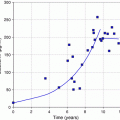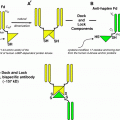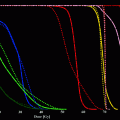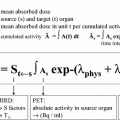Myeloablative radioimmunotherapy
Aim of therapy
Reduction of tumor cell number
Conditioning prior to SCT by:
Reduction of tumor cell number
Myeloablation
Antibody specification
Tumor cell affinity
Bone marrow affinity
(Tumor cell affinity)
Applied doses
>8–10 Gy
>8–10 Gy
Hematological toxicity
Severe
Ablative
Toxic side effect, unwanted
Severe
Ablative
Major therapy aim, wanted
SCT
Yes, autologous SCT, as “stem cell rescue”
Yes, allogeneic or autologous SCT as main therapy
Example of targeted tumors
High-dose radioimmunotherapy of solid tumors or NHL with autologous “stem cell rescue”
Acute leukemia prior to allogeneic SCT
5.1 Myeloablation as the Major Therapy Aim
If radioimmunotherapy (RIT) is used in the context of a conditioning regimen prior to stem cell transplantations it might comprise for both, myeloablation and reduction of the medullar tumor load. The radioactive antibodies bind to cells of the normal hematopoietic bone marrow and operate by cross-fire effect that covers the medullar compartment. Additionally, specific binding to the malignant cells is necessary only for two reasons: (a) The bone marrow is highly infiltrated by leukemic blasts and antigen-expressing normal hematopoiesis is largely replaced, or (b) tumor cells are also presented extramedullary.
5.2 Myeloablation as a Toxic, Unwanted Side Effect
Outside of conditioning protocols, radioimmunotherapy is used in the treatment of hematological malignancies such as nonHodgkin Lymphoma and also of solid tumors. Unwanted myeloablation by RIT may occur as a side effect even if the tumors are mainly localized outside the bone marrow: The radiolabeled antibodies accumulate in the bone marrow even if only some tumor cells are infiltrating the bone marrow or if the targeted antigen is not selective for the malignant cells, but is also expressed on healthy hematopoietic cells. In these cases, autologous stem cell support is required to limit severe therapy-induced cytopenia and thereby prevent life-threatening complications such as severe infections caused by persistent immunosuppression (Richman et al. 2005; Behr 2002; Nademanee et al. 2005).
6 Dosimetry in Myeloablative Conditioning Radioimmunotherapy
The applied bone marrow dose is limited to 35–40 Gy in order to avoid stroma cell damage that may affect the engraftment of transplanted stem cells (Matthews et al. 1995). However, the maximum tolerated dose (MTD) for the bone marrow has yet to be defined. For liver and kidneys, upper limits have been defined at 10–12 Gy (Buchmann et al. 2002a, b, c; Bunjes et al. 2001). The radioimmunoconjugates that currently have been used for myeloablative conditioning do not result in critical lung doses.
To calculate the specific organ doses an individual dosimetry has to be performed for at least 2 days. The protocols are variable but mostly include two whole-body scintigraphies and radioactivity measurements of the collected urine per day and single examinations at the following days. In each scintigraphy, regions of interest (ROI) are drawn around the whole body, liver, kidneys, spleen, lungs and, exemplarily for the bone marrow, around the lumbar vertebral body four or the os sacrum and the estimated radiation absorbed doses are usually calculated using the MIRD-formalism (Loevinger and Berman 1976). A precise microdosimetrical estimation of the hematopoietic marrow dose still remains an unresolved topic, and the miscalculation is supposed to be in a relevant range.
7 Radioactive Nuclides
7.1 α– Particles
α -particles have a short pathlength of 50–100 μm and a high linear energy transfer (approximately 100 keV/μm). For the safe use of α-particles, antibodies with very high tumor cell specificities and affinities are required, and the radio labeling has to be highly stable in vivo. Dissociation of the antibody and unspecific binding of the radioimmunoconjugate may induce relevant side effects (Mulford 2005).
As a result of their low tissue range, inappropriate half life (Table 2) and very restricted availability, α-particle emitters such as 213Bismut (213Bi) and 225Actinium (225Ac) are only sporadically used in clinical trials. They are not sufficiently myeloablative to be used in conditioning prior to hematopoietic stem cell transplantation.
Table 2
Physical characteristics of isotopes with relevance for therapy
Isotope | Irradiation | Physical half life | Maximum/mean particle energy (MeV)a | Maximum/mean tissue range (mm) of particles |
|---|---|---|---|---|
131Iodide | β −, γ | 8 days | 0.6/0.19 | 2.1/0.4 |
177Lutetium | β −, γ | 6.7 days | 0.5/0.15 | 1.6/0.3 |
188Rhenium | β −, γ | 17 h | 2.1/0.8 | 10/3.1 |
90Yttrium | β − | 2.7 days | 2.3/0.9 | 11/3.8 |
225Actinium | α | 10 days | 5.8 and 8.4 | 0.04–0.08 |
213Bismut | α | 46 min | 5.9 | 0.05–0.07 |
7.2 β −-Emitting Nuclides
β −-emitting nuclides emit electrons. β − particles with higher tissue ranges of up to 10 mm are ideal for both, the treatment of larger tumor cell conglomerates and for myeloablative conditioning before stem cell transplantation. β − particles with lower tissue ranges are favorable for the treatment of minimal residual disease and marginal tumor cells.
7.2.1 90Yttrium
90 Yttrium (90Y) is a generator nuclide that is commercially available. It has a high cross-fire effect and is one of the most qualified β − -emitter for use in clinical trials of myeloablative conditioning so far. As a pure β − -emitter, the unspecific irradiation exposure of patients, medical staff, and family members is low which allows application in outpatient protocols. The half life (t1/2) (Table 2) is short enough to transfer the patient from the nuclear medicine ward to the transplantation ward before the hypoplasia/aplasia becomes clinically relevant. In addition, it does not compromise the hematopoietic engraftment. 90Y is stably conjugated to the antibody by chelators derived from DTPA (diethylenetriaminepentaacetic acid) or DOTA (1,4,7,10-tetraazacyclododecane-tetraacetic acid). The formation of DOTA complexes is a slow reaction and the use of the acyclic chelators derived from DTPA therefore is favored for the labeling of peptides. The backbone substituted derivates of the chelator DTPA provide a higher complex stability compared to DTPA and can, therefore, be used for in vivo applications. Several methyl substituted isomers of DTPA have been studied. The most common derivatives are ITC-CHX-DTPA ((2-(4-isothiocyanatobenzyl)-cyclohexyldiethylenetriaminepentaacetic acid), ITC-1B4 M-DTPA, also known as MX-DTPA (2-(4-isothiocyanatobenzyl)-6-methyl-diethylenetriamine pentaacetic acid) and ITC-2B3 M-DTPA (2-(4-isothiocyanatobenzyl)-3-methyl-diethylenetriamine pentaacetic acid). CHX-DTPA has been shown to be less suited than ITC-1B4 M-DTPA (MX-DTPA) with regard to serum stability and biodistribution (Camera et al. 1994).
Because 90Y is a pure β − -emitter, it is not suitable for dosimetry. Exact data can be obtained from positron emission tomography with 86yttrium (86Y). 86Y is chemically identical to 90Y, but is expensive, has a restricted availability, induces a high radiation exposure for the patient and medical staff and requires complex measurement techniques (Loevinger and Berman 1976). It is not practicable in clinical routine. Therefore, 111In is most frequently used for dosimetry prior to 90Y-therapy. It emits γ-quants with 171 and 245 keV and can be imaged by γ -cameras.
7.2.2 131Iodide
131 Iodide (131I) is a commercially available reactor nuclide. It emits both, β −– and γ-irradiation (predominantly 364 keV) (Table 2). It is efficient for dosimetry as well as for therapy. The cross-fire effect is low, and the long t1/2 of 8 days of the γ-component requires an isolation of the patients on the nuclear medicine ward for 1–2 weeks. Free 131I accumulates in the thyroid which has to be blocked by a prophylactic, oral application of sodium perchlorate. Radiolabeling procedures are simple. Since labeling techniques for 90Y have been established, 131I is rarely used for myeloablative conditioning.
7.2.3 188Rhenium
188 Rhenium (188Re) is a generator nuclide with limited commercial availability (188Wi/188Re-generator, Oak Ridge National Laboratory, Oak Ridge, TN, USA). It emits both, β − – and γ-irradiation (155 keV) and can be used for dosimetry and therapy. Radiolabeling of the antibody is carried out by complex formation with disulfide bridges. The cross-fire effect and its half-life (Table 2) are sufficient for myeloablative schemes. Free, circulating perrhenate accumulates in the thyroid, and a thyroid blockade with sodium perchlorate is essential.
The most serious disadvantage in comparison with 90Y-labeled antibodies is the significant higher nephrotoxicity of 188Re-labeled antibodies and the restricted availability (Zenz et al. 2006).
7.2.4 177Lutetium
177 Lutetium (177Lu) is a commercially available reactor nuclide. It is conjugated to the mAb by the same chelators as 90Y. 177Lu is a β − -emitter with a γ-component with 208 keV in 11 % of decays. It is suitable for both dosimetry and therapy. Particle energy, tissue range and the cross-fire effect are considerably lower than for 90Y and 188Re but more similar to 131I. Compared with 131I, the conjugation to the antibody is more stable and the t½ is shorter. 177Lu is suitable for the treatment of small tumor conglomerates, extramedullar minimal residual disease, and marginal medullar tumor cells. It has not been used in the conditioning of patients prior to stem cell transplantation so far, but is well established in internal radiotherapies of neuroendocrine tumors (Frilling et al. 2006).
8 Antibodies
In actual clinical trials, antibodies with specificity for CD33, CD45, and CD66 are used for myeloablative conditioning of patients with AML, MDS, or MM prior to stem cell transplantation. All antibodies bind to normal hematopoietic cells. Anti-CD66-mAb (Ratai et al. 2008) binds to leukemic blasts to a lower proportion than anti-CD33- and anti-CD45-mAb.
8.1 Anti-CD33-Antibodies
Anti–CD33–antibodies. CD33 is expressed from the stages of promyelocytes to mature myeloid cells and most AML blasts. It is classically not expressed on ALL-B and ALL-T blasts. Currently, two different anti-CD33-antibodies are used in clinical trials: The murine antibody M195 (Scheinberg et al. 1989) (isotype IgG2a) and the humanized antibody HuM19540,41. They are not approved for myeloablative radioimmunotherapy.
8.2 Anti-CD45-Antibodies
Anti–CD45–antibodies. The CD45 antigen is expressed on almost all leucocytes with exception of plasma cells and is also expressed on 80–95 % of all leukemic blasts of the myeloid and lymphoid line and on the clonogenic myeloma “stem” cell (Matsui et al. 2004). For myeloablative conditioning, the murine antibody BC8 (isotype IgG1) (Matthews et al. 1995, 1999), the rat antibody YTH24.5 (isotype IgG2b) (Buchmann et al. 2003), and the rat antibody YAML568 (isotype IgG2a) (Glatting et al. 2006) have been studied in clinical trials. None of these antibodies is approved for radioimmunotherapy.
8.3 Anti-CD66-Antibodies
Anti–CD66–antibodies. CD66 antigens belong to the group of NCA (nonspecific cross-reacting antigens). CD66b is expressed in the stages from promyelocytes to mature granulocytes but rarely on myeloid leukemic blasts. The murine anti-CD66b-mAb BW250/183 (isotype IgG1) (NCA 95) is commercially available (Scintimun® (Besilesomab), CIS bio international, Schering AG, Switzerland), and approved for diagnostic 99mtechnetium (99mTc) scintigraphies for the imaging of infection, but not for radioimmunotherapy approaches.
9 Clinical Radioimmunotherapy Trials
Feasibility, applied organ doses, toxicities and primary response data of myeloablative radioimmunotherapy have already been acquired in clinical conditioning studies (Table 3), and the specific organ doses and the ratios of marrow/organ doses of some selected 188Re- and 90Y-radioimmunoconjugates are summarized in Table 4. Randomized studies comparing the efficiency of conditioning schemes with or without myeloablative radioimmunotherapy, however, have not been performed so far. Comparison with historical groups is mainly inadequate, because the transplantation protocols among studies as well as the patient’s therapeutic histories were diverse.
Table 3
Overview of the actual literature of selected trials
Antigen | Antibody | β −isotope | Radioimmunoconjugate | Disease | Authors |
|---|---|---|---|---|---|
CD 33 | M195 | 131I (β −) | 131I-M195 | AML, MDS | Schwartz et al. 1993 |
CD 33 | HuM195 | 131T (β −) | 131T-HuM195 | AML | Burke et al. 2003 |
CD 45 | BC 8 | 131I (β −) | 131I-BC 8 | AML, ALL, MDS | Matthews et al. 1995 |
CD 45 | BC 8 | 131I (β −) | 131I-BC 8 | AML, ALL, MDS | Matthews et al. 1999 |
CD 66 | BW250/183 | 188Re (β −) | 188Re-BW250/183 | AML, MDS | Bunjes et al. 2001 |
CD 66 | BW250/183 | 188Re (β −) | 188Re-BW250/183 | AML, MDS | Bunjes 2002 |
CD 66 | BW250/183 | 188Re (β −) | 188Re-BW250/183 | AML, CML, MDS | Reske et al. 2001 |
CD 66 | BW250/183 | 188Re (β −) | 188Re-BW250/183 | AML, MDS, CML, ALL | |
CD 66 | BW250/183 | 188Re, 90Y (β −) | 188Re- and 90Y- BW250/183 | AML, MDS (elderly patients) | Ringhoffer et al. 2005 |
CD 66 | BW250/183 | 188Re, 90Y (β −) | 188Re- and 90Y- BW250/183 | AML, MDS, ALL, CML, CLL | Zenz et al. 2006 |
Table 4
Specific organ doses, marrow/organ ratios and favorite indications of different radioimmunoconjugates
Radioimmunoconjugate | Specific doses (Gy/GBq) | Dose ratios marrow: Organ | Favorite indication | |||
|---|---|---|---|---|---|---|
Marrow | Liver | Kidney | Liver | Kidney | ||
188Re-anti-CD66-mAb BW250/18328 | 1.4 ± 0.5 | 0.6 ± 0.3 | 0.7 ± 0.4 | 2.3b | 2.0b | (AML, MDS with a low tumor load) |
90Y- MX-DTPA- anti-CD66-mAb BW250/18348 | 6.8b | 3.4b | 1.3b | 2.0b | 5.2b | (AML, MDS with a low tumor load) |
90Y-2B3 M-DTPA- anti-CD66-mAb BW250/18351 | 10.2 ± 1.8 | 2.7 ± 2 | <1.0b | 3.8b | 9.2b | Monotherapy: AML, MDS with a low tumor load and without extramedullar tumor cell infiltrations |
90Y-MX-DTPA- anti-CD45 YAML56844a | 6.4 ± 1.2 | 3.9 ± 1.4 | 1.1 ± 0.4
Stay updated, free articles. Join our Telegram channel
Full access? Get Clinical Tree
 Get Clinical Tree app for offline access
Get Clinical Tree app for offline access

| |||





